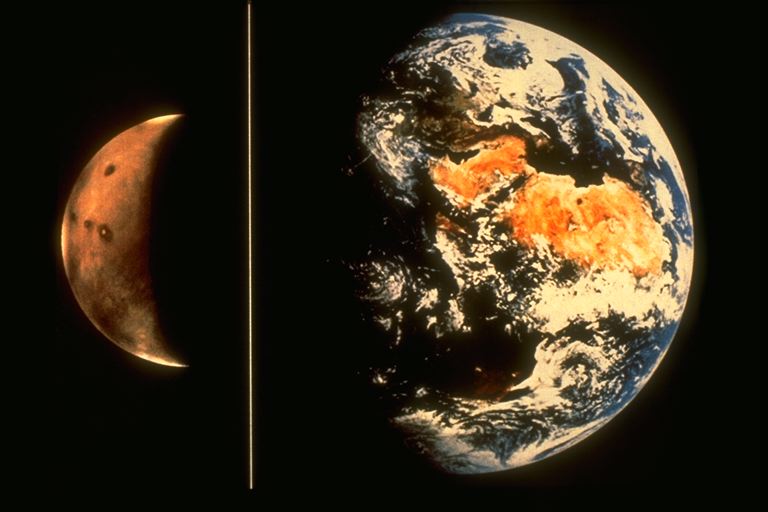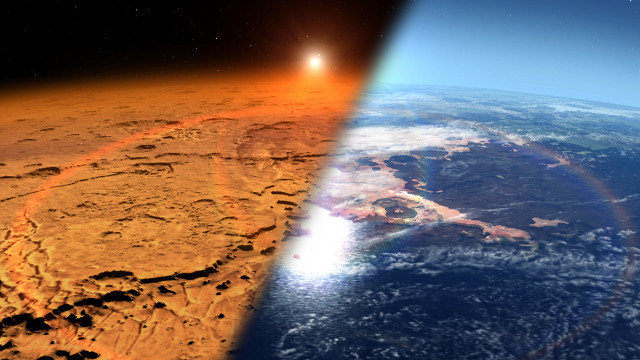Within our own solar system are the most diverse cosmic bodies. We call them planets, but the properties of each of them are unique. So, the first four, located closest to the star, are included in the category of “terrestrial planets”. They have a core, mantle, solid surface and atmosphere. The next four are gas giants with only a core clad in a wide variety of gases. But on the agenda we have Mars and Earth. Comparison of these two planets will be fascinating and exciting, especially considering the fact that both of them are representatives of the "earth category".
Introduction
Astronomers of the past, after they discovered Mars, believed that this planet is the closest relative of the Earth. The first comparisons of Mars and the Earth are related to the system of channels seen through a telescope, which was used to encircle the red planet. Many were convinced that there was water and, as a result, organic life. It is likely that millions of years ago this object within the solar system had conditions similar to today's earthly ones. However, now more than precisely managed to establish: Mars - the red desert. Nevertheless, comparisons of Earth and Mars are a favorite topic of astronomers to this day. Studying the features of the structure and rotation of our closest neighbor, they believe that soon this planet will be able to colonize. But there are nuances that so far prevent humanity from taking this step. We will learn about what they are and what they are by drawing an analogy on all points between our native Earth and the mysterious neighboring Mars.

Weight, size
These indicators are the most important, so we will start by comparing the sizes of Mars and the Earth. Even in children's books on astronomy, we all noticed that the red planet is slightly smaller than ours, about one and a half times. Let's look at this difference on specific numbers.
- The average radius of the Earth is 6371 km, and on Mars this indicator is 3396 km.
- The volume of our native planet is 1.08321 x 10 12 km 3, while the Martian is equated to 1.6318 × 10¹¹ km³, that is, 0.151 of the Earth’s volume.
The mass of Mars in comparison with the Earth is also smaller, and this indicator differs dramatically, unlike the previous one. Earth weighs 5.97 × 10 24 kg, and the red planet is satisfied with only 15 percent of this indicator, namely 6.4185 x 10 23 kg.
Orbital features
From the same children's astronomical textbooks, we know that Mars, due to the fact that it is more distant from the Sun than the Earth, is forced to walk in a larger orbit. It is about twice as large as the earthly one, and actually, the year on the red planet is twice as long. From this we can conclude that this cosmic body rotates at a speed comparable to the Earth. But it is important to know this data in exact numbers. The Earth’s distance from the Sun is 149 598 261 km, but Mars is located at a distance of 249.2 billion km from our star, which is almost double. The orbital year in the kingdom of dusty and red desert is 687 days (we remember that on earth the year lasts 365 days).

It is important to note that the sidereal turnover of the two planets is almost the same. The day on Earth is 23 hours and 56 minutes, and on Mars - 24 hours and 40 minutes. The axial inclination cannot be ignored. For the Earth, a characteristic indicator is 23 degrees, and for Mars - 25.19 degrees. It is likely that there may be seasonality on the planet.
Composition and structure
Comparison of Mars and the Earth will be incomplete if we ignore the structure and density of these two planets. Their structure is identical, since both belong to the earth group. In the center is the core. In the Earth, it consists of nickel and metal, and the radius of its sphere is 3,500 km. The Martian core has the same composition, but its spherical radius is 1800 km. Then, on both planets there is a silicate mantle, followed by a dense crust. But the earth’s crust differs from the Martian in the presence of a unique element - granite, which is not present anywhere else in space. It is important to note that the depth of the earth's crust is on average 40 km, while the Martian crust reaches up to 125 km in depth. The average density of the Earth is 5.514 grams per cubic meter, and Mars - 3.93 grams per cubic meter.
Temperature and atmosphere
At this point, we are confronted with fundamental differences between two neighboring planets. And the thing is that in the Solar system, only one Earth is equipped with a very dense air shell, which maintains a unique microclimate on the planet. So, a comparison of the atmosphere of Earth and Mars is worth starting with the fact that the first air layer has a complex, five-step structure. We all taught school terms such as the stratosphere, exosphere, etc. The Earth’s atmosphere consists of 78 percent nitrogen and 21 percent oxygen. On Mars, the same layer is one, very thin, which consists of 96 percent carbon dioxide, 1.93% argon and 1.89% nitrogen.
It also caused a difference in temperature. On Earth, the average is +14 degrees. It rises to a maximum of +70 degrees, and drops to -89.2. Mars is much cooler. The average temperature is -46 degrees, while the minimum temperature is 146 below zero, and the maximum temperature is 35 with a + mark.
Gravity
In this word, the whole essence of our being on a blue planet. It is she who is the only one in the solar system that can provide gravity, acceptable for the lives of people, animals and plants. We mistakenly believed that gravity is absent on other planets, but it is worth saying that it is there, just not as strong as ours. The attraction on Mars in comparison with the Earth is almost three times less. If we have an indicator such as G - that is, the acceleration of gravity is 9.8 m / s squared, then on a red desert planet it is equal to 3.711 m / s squared. Yes, you can walk on Mars, but without a special suit with cargo, alas, it will not work.
Satellites
The only moon on Earth is the moon. She not only accompanies our planet on its mysterious cosmic path, but also is responsible for many natural processes in life, for example, tides. The moon is also the most studied cosmic body at the moment, as it is closest to us. Escort of Mars - Deimos and Phobos. The satellites were discovered in 1877 and named after the sons of the war god Ares (translated as “fear” and “horror”). It is most likely that they were attracted by the gravity of the red planet from the asteroid ring, since their composition is identical to all the other stones rotating between Mars and Jupiter.